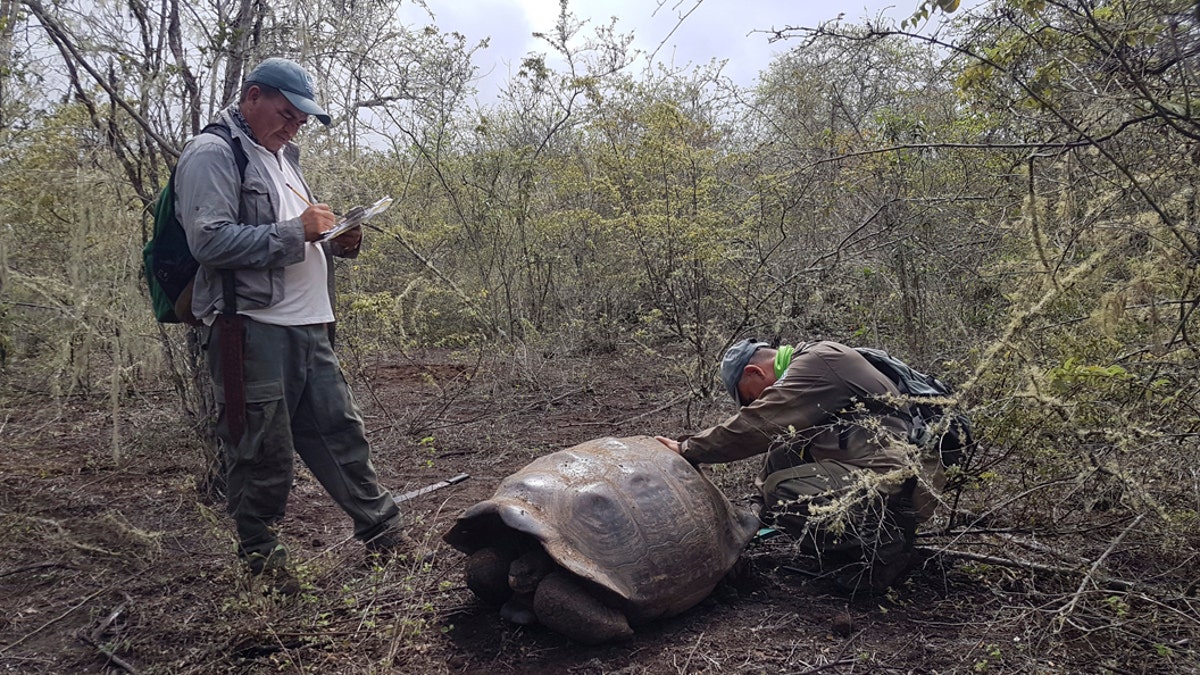Fox News Flash top headlines for Feb. 4
Fox News Flash top headlines for Feb. 4 are here. Check out what's clicking on Foxnews.com.
Conservationists working around the Wolf Volcano on Galapagos Islands say they have discovered 30 giant tortoises that are partially descended from two species that have gone extinct, including the famous Lonesome George, who died in 2012.
The Galapagos National Park and Galapagos Conservancy said Friday that it had discovered a young female that has a direct line of descent from the Chelonoidis abingdonii species of Pinta Island. Lonesome George was the last of these tortoises and died around age 100 from natural causes.
After Lonesome George was embalmed and exhibited at the American Museum of Natural History in New York, he was returned to Ecuador and put on display in 2017.

In this Jan. 25, 2020 photo released by Galapagos National Park shows park workers inspecting a tortoise near Wolf Volcano on Galapagos Islands, Ecuador. The National Park announced on Friday, Jan. 31, 2020 that an expedition to the foothills of the highest active volcano in the Galapagos Islands located a young female tortoise and she is a direct descendant of a giant tortoise species considered extinct. (Tui De Roy/Galapagos National Park via AP)
TORTOISE THOUGHT TO BE EXTINCT FOR 113 YEARS HAS BEEN REDISCOVERED ON THE GALAPAGOS
In addition to finding the young reptile, another 18 females and 11 males from the Chelonoidis niger line of Floreana Island were also discovered.
The expedition, comprised of 45 members, was working near the 5,600-foot high volcano on Isabela island when they made the discovery. It is believed that pirates and whalers had taken the tortoises from other islands in the archipelago and left them near the volcano.
The tortoises that were discovered in the new expedition are hybrids from not only extinct species, but other species as well. The Galapagos Islands have 15 species of tortoise that are closely related. According to the Conservancy, between 20,000 and 25,000 tortoises are estimated to live on the island that once inspired Charles Darwin.

In this Jan. 25, 2020 photo released by Galapagos National Park a helicopter transports tortoises near Wolf Volcano on Galapagos Islands, Ecuador. The National Park announced on Friday, Jan. 31, 2020 that an expedition to the foothills of the highest active volcano in the Galapagos Islands located a young female tortoise and she is a direct descendant of a giant tortoise species considered extinct. (Tui De Roy/Galapagos National Park via AP)
At least four of the species are now considered extinct.
THE FASCINATING SEX LIFE OF JONATHAN, THE 185-YEAR-OLD GIANT TORTOISE
In 2019, a Fernandina Tortoise, which was thought to have become extinct in 1906, was also spotted in the Galapagos.
Tortoises have been in the spotlight in recent years. Jonathan, the famous giant tortoise who resides on the remote South Atlantic island of St. Helena, made headlines in 2017 when the Times reported that Frederica, the tortoise he had been “wooing” for 26 years, may actually be a "Frederic."
Jonathan, who is approximately 187 years old, is believed to be the world’s oldest living land animal.
CLICK HERE TO GET THE FOX NEWS APP
The Associated Press and Fox News' James Rogers contributed to this report.

